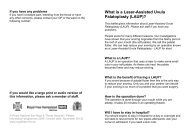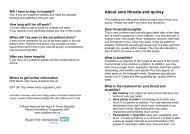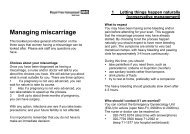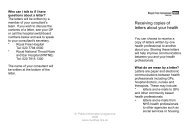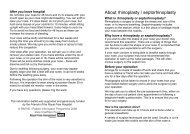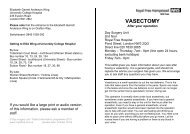PUVA treatment - Royal Free Hampstead NHS Trust
PUVA treatment - Royal Free Hampstead NHS Trust
PUVA treatment - Royal Free Hampstead NHS Trust
Create successful ePaper yourself
Turn your PDF publications into a flip-book with our unique Google optimized e-Paper software.
© Department of Dermatology / Patient Information Programme 2003<br />
www.royalfree.nhs.uk<br />
<strong>PUVA</strong> <strong>treatment</strong>
Contents<br />
page<br />
Introduction 1<br />
What is <strong>PUVA</strong> <strong>treatment</strong>? 1<br />
How is psoralen given? 1<br />
Oral 2<br />
Topical 3<br />
Bath 3<br />
What is involved in UVA light therapy? 4<br />
Test dose 4<br />
Procedure on the day 5<br />
Short-term side effects 6<br />
Long-term side effects 7<br />
What you need to do during <strong>treatment</strong> 9<br />
Notes 12<br />
Introduction<br />
This booklet gives information about <strong>PUVA</strong><br />
<strong>treatment</strong>. Please ask staff if you have any<br />
questions.<br />
Ultraviolet (UV) light is widely used by<br />
dermatologists for skin conditions. The choice of<br />
UV over other forms of <strong>treatment</strong> depends on<br />
things such as a patient’s age, disease, skin type,<br />
previous <strong>treatment</strong>s and current medication. The<br />
doctor will discuss with you why he / she feels UV<br />
is best for you. UV is not a long-term cure, but it<br />
can improve your condition significantly for a<br />
period of time.<br />
What is <strong>PUVA</strong> <strong>treatment</strong>?<br />
"<strong>PUVA</strong>" stands for the use of a psoralen drug (P)<br />
in combination with Ultraviolet A (UVA) light. The<br />
purpose of the psoralen is to make the skin more<br />
sensitive to the ultraviolet light. The ultraviolet<br />
light is emitted by special lamps which are only<br />
available at certain medical centres. <strong>PUVA</strong><br />
therapy can only be carried out in a hospital<br />
under medical supervision.<br />
How is psoralen given?<br />
There are three methods: oral (by mouth), topical<br />
(directly on the affected skin) and bath.
1. Oral<br />
The psoralen tablet is usually taken two hours<br />
before exposure to the UVA light. The dose<br />
depends on your height and weight. The tablets<br />
should not be taken on an empty stomach but<br />
with food eg. a light meal or banana.<br />
It is important to protect your eyes when having<br />
oral psoralen because tablets sensitise your skin<br />
and eyes to sunlight for up to 24 hours depending<br />
on your skin condition. To prevent the risk of<br />
cataracts, you must wear sunglasses - the nurses<br />
will advise you for how long.<br />
Sunglasses from Boots labelled “UVA/UVB 100%<br />
protected” are suitable. We can test your current<br />
sunglasses for you; and may also be able to loan<br />
you a pair. If you would prefer to wear your<br />
ordinary glasses, staff can advise on suitable<br />
coatings for the lenses.<br />
You need protection from sunlight through<br />
window glass, bare fluorescent tubes and<br />
halogen lamps. Protection is not needed from<br />
ordinary light bulbs; light from television and<br />
computer screens; lights with plastic diffusion<br />
covers; or at night-time.<br />
2. Topical<br />
This is used to treat small areas of skin. It may be<br />
applied as a solution, gel or paint. The doctor will<br />
decide which type is most appropriate for you.<br />
Whichever is chosen, it will be applied in the<br />
phototherapy unit with the help of the nurse.<br />
Paint / gel must be applied evenly and accurately<br />
for each <strong>treatment</strong> session. Following application,<br />
you have to wait 15 minutes before having UVA<br />
therapy to allow the psoralen to be absorbed.<br />
3. Bath<br />
This involves soaking in a bath of psoralen<br />
solution for 15 minutes before your UVA<br />
<strong>treatment</strong>. The solution is showered off after<br />
<strong>treatment</strong> with a soap substitute eg. aqueous<br />
cream.<br />
Tips: Spread the psoralen around the water to<br />
ensure it is well mixed * Immerse your whole<br />
body to ensure maximum coverage * Avoid<br />
splashing the face or eyes with the solution *<br />
Gently agitate the water when soaking * Gently<br />
pat the skin dry before UVA <strong>treatment</strong>.<br />
For a basin <strong>PUVA</strong>, hands and/or feet are soaked<br />
for 15 minutes before UVA therapy.
General tips<br />
The skin remains sensitive to light for 24 hours,<br />
so avoid further UV exposure during this period,<br />
(either sunbeds or natural. Eye protection<br />
following topical or bath <strong>treatment</strong> is not<br />
necessary.<br />
What is involved in UVA light therapy?<br />
The UVA part of your <strong>treatment</strong> usually takes<br />
place in a specially designed stand-up-cabinet,<br />
which is lined with UVA-emitting fluorescent<br />
lamps. Patients with skin disease just affecting<br />
the hands and feet receive light to those sites<br />
only via a smaller portable unit.<br />
Following assessment in the phototherapy clinic,<br />
we will show you the machine, and discuss the<br />
days and times of your <strong>treatment</strong> with you.<br />
Treatment is usually twice a week for<br />
approximately 6-10 weeks.<br />
Test dose<br />
If you are having full body <strong>treatment</strong>, and<br />
depending on your skin type, we may do a test of<br />
light on your back to work out your starting dose.<br />
72 hours later the phototherapy nurse will read<br />
the results, and <strong>treatment</strong> will start.<br />
Procedure on the day<br />
Before you get in the machine we will ask you to<br />
undress and change into a gown. The nurse will<br />
assess your skin before each <strong>treatment</strong>. You get<br />
in the cabinet for <strong>treatment</strong>, the nurse explains<br />
how you should stand and you will remove your<br />
gown. Initially, <strong>treatment</strong> takes only a few minutes<br />
(or even seconds), gradually increasing to a<br />
maximum of around twenty five minutes. The<br />
dose increase on each visit depends on your skin<br />
type, skin disorder and the response to the<br />
previous <strong>treatment</strong>.<br />
After <strong>treatment</strong> it is not unusual to develop mild<br />
skin redness. Please tell the nurse at your next<br />
appointment if, a few hours after <strong>treatment</strong>, you<br />
felt hot, uncomfortable or your skin remained red.<br />
You may wear protective eye goggles and a face<br />
visor while inside the cabinet - the nurse will<br />
advise you. If your skin condition is affecting the<br />
eyelids, we may expose this area after discussion<br />
with the phototherapy nurse. If goggles are not<br />
worn, eyelids must be kept firmly shut. Face<br />
visors are used if your face does not require<br />
<strong>treatment</strong>. Again, the nurse will advise you.
Short-term side effects<br />
We make every effort to avoid problems but<br />
occasionally side effects can occur, such as:<br />
Redness The main risk of <strong>PUVA</strong> therapy in the<br />
short term is sunburn-like reactions, particularly<br />
for people with fair skin. We try to avoid this by<br />
increasing the light therapy very slowly.<br />
We aim to produce a mild redness after every<br />
<strong>treatment</strong>. However, if your skin becomes<br />
uncomfortable or hot please report it to the nurse<br />
on the phototherapy number below. If it is<br />
extremely uncomfortable or blistered please<br />
report it immediately. Out-of-hours, please<br />
contact the hospital switchboard on 020 7794<br />
0500 and ask to speak to the on-call<br />
dermatologist. You will need to explain to the<br />
doctor that you have had UVA <strong>treatment</strong> and<br />
describe your symptoms. If this is problematic, go<br />
to the accident and emergency department,<br />
taking this leaflet with you – they will contact the<br />
on-call dermatologist for you. We sometimes<br />
suspend <strong>treatment</strong> and creams until symptoms<br />
settle.<br />
Dry skin Skin can become dry during <strong>treatment</strong><br />
and for some time afterwards. Applying an<br />
emollient to the whole skin at least twice a day will<br />
help keep the skin hydrated / supple.<br />
Itching UV therapy can cause itching, particularly<br />
during the first two weeks of therapy. Emollients<br />
and antihistamine may be required to treat this.<br />
Cold sores (Herpes Simplex virus) Those who<br />
have had cold sores in the past may get a repeat<br />
infection. Apply lip sunscreen to the lips before<br />
every <strong>treatment</strong> to prevent this.<br />
Folliculitis Small pustules and minor<br />
inflammation around the hair follicle can occur.<br />
This does not cause discomfort, and <strong>treatment</strong><br />
can proceed. Applying moisturiser in a downward<br />
motion before <strong>treatment</strong> may help to prevent this.<br />
Photosensitivity If you usually develop a rash<br />
with sunlight (e.g. prickly heat), you may suffer a<br />
flare-up with UV <strong>treatment</strong>. If this occurs, tell the<br />
phototherapy nurse and we may suggest<br />
<strong>treatment</strong> to ease the symptoms.<br />
Nausea Should this occur and if intolerable,<br />
please tell the nurse as we may be able to<br />
change your tablets. Taking your tablets with a<br />
banana or light meal may help.<br />
Please ask staff if you have any concerns<br />
about these side effects.
Long-term side effects<br />
Photoageing Frequent exposure to UV may<br />
cause ageing changes in the skin, such as<br />
freckles & wrinkles.<br />
Skin cancer If you have a lot of <strong>treatment</strong>s (more<br />
than 200) you will have an increased risk of skin<br />
cancer. Your <strong>treatment</strong> and follow up<br />
examinations will take this into account. If you<br />
notice any early signs (for example the beginning<br />
of a small lump) tell the dermatology staff. These<br />
are not serious if detected early.<br />
<strong>PUVA</strong> freckles Patients who have had a lot of<br />
<strong>PUVA</strong> may develop dark freckles which may be<br />
permanent.<br />
Actinic keratoses These are small patches of<br />
scaly skin, which may be pre-cancerous, but are<br />
easily are treatable.<br />
Please remember there is a limit to the amount of<br />
UV therapy you can have in your lifetime. We<br />
keep records to avoid exceeding the<br />
recommended amount. Lower limits may be<br />
applied for those who have bath <strong>PUVA</strong> or who<br />
have other skin cancer risk factors.<br />
Please ask the nurse or doctor if you want more<br />
information.<br />
If you experience any complications outside office<br />
hours, please contact the on-call dermatologist<br />
via the main switchboard on 020 7794 0500 or go<br />
to casualty, taking this leaflet with you and ask<br />
them to contact the on-call dermatologist.<br />
What you need to do during <strong>treatment</strong><br />
• On <strong>PUVA</strong> days, before <strong>treatment</strong>, please apply<br />
a moisturiser e.g. Diprobase cream, aqueous<br />
cream, Cetraben etc. Avoid tar, steroid and<br />
vitamin preparations. After <strong>treatment</strong> and on non<strong>treatment</strong><br />
days, the regular and liberal use of any<br />
moisturiser is recommended, as well as your<br />
topical <strong>treatment</strong>s.<br />
• You should tell the nurse in advance when you<br />
are running out of <strong>treatment</strong>s, so that a<br />
prescription can be ready for you at your next<br />
visit. It is your responsibility to collect your<br />
prescriptions from the phototherapy and<br />
pharmacy departments. Ask staff for directions.<br />
• Always inform the nurse if you are taking, or<br />
about to start, new medication or creams while<br />
having <strong>treatment</strong>, as some <strong>treatment</strong>s can make<br />
you more sensitive to UV light.<br />
• Perfumes can make you more sensitive to<br />
sunlight so avoid using scented products such as
ath foam, deodorant, perfumes and after-shave<br />
lotions before <strong>treatment</strong> on <strong>PUVA</strong> days. You can<br />
apply these after <strong>treatment</strong> or direct to clothing<br />
on <strong>treatment</strong> days.<br />
• Over the period of <strong>treatment</strong> do not use a<br />
sunbed or sunbathe. On brighter days, protect<br />
exposed areas of skin from sunlight by wearing a<br />
hat, long sleeves, sunblock etc.<br />
• Avoid haircuts or hairstyle changes midway<br />
through <strong>treatment</strong>, as newly exposed areas are<br />
likely to burn.<br />
• If you wear jewellery (eg. rings) at the first<br />
<strong>treatment</strong>, wear them at every <strong>treatment</strong><br />
thereafter; otherwise you may burn at newly<br />
exposed sites.<br />
• If you wear any clothes in the cabinet it is<br />
important to wear the same ones each time to<br />
cover up the same parts of your body for even<br />
exposure purposes.<br />
• Women: <strong>PUVA</strong> is not recommended during<br />
pregnancy. You should avoid getting pregnant<br />
during a course of <strong>PUVA</strong>. If you do fall pregnant<br />
please tell the medical staff.<br />
• Men need to cover their genitals with dark<br />
underwear, sock or a jock strap for every<br />
<strong>treatment</strong>. Protective clothing is essential - please<br />
do not forget!<br />
• Avoid alcohol before <strong>treatment</strong> (on the day).<br />
• Please call the nurse if you experience any<br />
discomfort in the machine.<br />
• Some plants, vegetables and fruits (eg. celery,<br />
parsnips, figs or limes), have photosensitisers in<br />
them. These make you more sensitive to UV light,<br />
so please avoid handling them for at least two<br />
hours before <strong>treatment</strong>.<br />
• Regular and punctual clinic attendance is<br />
important. To avoid inconveniencing other<br />
patients, please be on time for your appointment<br />
- we may be unable to see late arrivals.<br />
• If you miss three appointments without<br />
notification the <strong>treatment</strong> will be withdrawn to<br />
allow <strong>treatment</strong>s for other patients. If you are<br />
unable to attend for <strong>treatment</strong> you should<br />
telephone the phototherapy unit 020 7830 2946<br />
to let the staff know.
<strong>PUVA</strong> therapy can only be given if you can<br />
commit to attending all the <strong>treatment</strong><br />
sessions within the prescribed course. If you<br />
cannot attend, <strong>PUVA</strong> therapy may not be the<br />
best <strong>treatment</strong> for you. If you want further<br />
information, please ask the nurse or ring 020<br />
7830 2946 during office hours (except NOT<br />
between 1230-1400hrs). If there is no reply<br />
please leave a message on the answerphone.<br />
Notes





